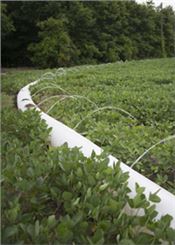|
Soybean Value Falls Just Shy Of $1B Mark

Mississippi soybean growers harvested the second highest soybean yield in state history in 2015,
but low market prices caused the crop to dip below $1 billion in value for the first time since 2011.
File photo by MSU Extension Service/Kat Lawrence
STARKVILLE, MISS.
Estimates indicate that lower soybean prices caused the value of Mississippi’s top row crop to drop below $1 billion for the first time since 2011 despite producers posting the second highest yield on record.
This year’s soybean crop has an estimated value of $930 million, a 26.4 percent decrease from $1.2 billion in 2014. Soybean is still the state’s third largest agricultural commodity. Only poultry and forestry, with estimated values of $3.2 billion and $1.2 billion, respectively, posted higher values. Including this year’s estimate, the five-year average value for soybeans is nearly $1.1 billion.
Brian Williams, agricultural economist with the Mississippi State University Extension Service, said he expects the soybean market to level off in 2016, even with soybeans selling for about $2.20 per bushel less than last year.
"The biggest issue in 2015 was the price of soybeans,” Williams said. “We are expecting a marketing year average of around $8.87 a bushel compared to $11.10 a bushel in 2014.”
Growers produced a record 52 bushels per acre in 2014. The 2015 estimated yield is 46 bushels per acre, which is the second best ever recorded in Mississippi.
The 2015 crop surpassed 2014 in total acres harvested. Growers harvested an estimated 2.28 million acres this year compared with 2.19 million acres last year.
Williams credits the production boost to improved management practices, more available soybean varieties and advances in technology.
“Dating back to 2012, we have had the four highest yields ever produced in the state,” he said. “A new record was set in 2012 at 45 bushels an acre, and, in 2013, producers tied that record. They shattered the old record with an average of 52 bushels an acre the next year, and now, in 2015, we have the second highest average yield on record.”
Extension soybean specialist Trent Irby said the 2015 growing season saw drastic extremes in weather, with a wet spring that delayed early plantings and a dry late summer that took a toll on yields in many areas of the state.
“Excessive rainfall during the beginning of the growing season caused issues for several producers, some of whom had to replant more than once to get this year’s crop established,” Irby said. “Some growers were able to plant during dry periods in April and May, but a few had to replant in late summer.”
The same spring weather patterns that forced those second and third plantings also caused some producers to switch from another crop to soybeans, which increased acreage. Irby said some producers who had planned to plant corn changed to soybeans after they were unable to establish a corn crop during its ideal planting window.
Given the right conditions, that trend could be reversed next year. Irby said planting intentions should stay consistent with five-year averages, but he expects a slight decrease from the amount of soybeans planted in 2015. He said several producers he spoke with opted to grow soybeans this year but are considering other options for 2016.
“The hope is that market conditions will improve and that we have more favorable early-spring weather next year,” Irby said. “Rotational needs, market prices and the planting environment will all dictate whether many producers grow more soybeans or rotate to another commodity. A lot of producers I’ve spoken with are thinking about broadening their portfolios.” ∆
|
|